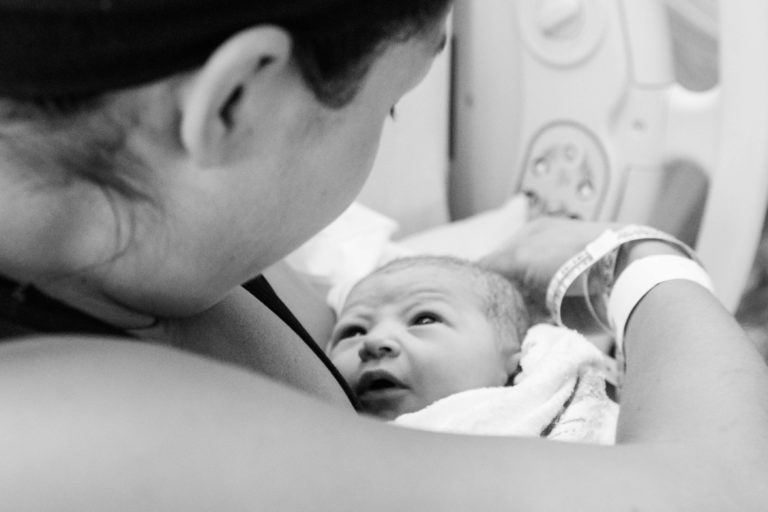Deciding what birth class to take during your pregnancy can be completely overwhelming. Instead of just deciding whether or not you want to attend a class, you also have to decide on which one to take. Online? In person? 12 weeks or 1 day? Hospital sponsored or independent?
If you’re like me, sometimes too many choices can lead to a phenomenom called analysis paralysis. I’m sure you know what I’m talking about – that feeling where the options are so varied and vast that you end up doing nothing.
Well, you’re in the right place. I’m here to break down your birth class options so you can choose the class that’s the right fit for you.
Before we dive into the options that are available – let’s answer a few key questions that can help us narrow down our choices.
What Topics Should a Birth Class Cover?
When you are evaluating a birth class, consider what you hope to learn from the class. Are you hoping for more of basic overview of labor and birth, or are you looking for more of an instructional, practical class?
A comprehensive birth class should cover the following topics:
- An overview of prenatal nutrition
- The biological and physiological process of pregnancy, labor and birth (basically, what happens to your body during pregnancy and birth)
- What to expect during labor and childbirth
- An overview of routine medical interventions (how can you know why you want to avoid them if you don’t know what they are and why they are used?)
- The partner’s role in pregnancy and birth and how he/she can support you effectively
- A variety of coping and pain management techniques, including labor positions and breathing techniques
- What pain management options will be available to you and guidance in making game-time decisions
- Hands-on practice
How Much Time and Resources Do You Have?
If you are 7 months pregnant, clearly a 12 week class would be a bad fit for you. Or maybe your partner works nights and you’d rather take an intense weekend class than a weekly class. Maybe the class that appeals to you the most is over an hour away. How realistic is it for you to plan to travel that far for each class? There are a wide variety of birth class options, so regardless of the answers to these questions, you should be able to narrow it down to one that works for you and your partner.
What Does Your Ideal Birth Look Like?
There is no wrong answer here.
Does the idea of giving birth unassisted in a forest give you heart eyes, or make you cringe and gasp? Do you see yourself enjoying meditations and hypnosis or do you want to take a more conventional approach? Does your partner want to take a more active role, or do you envision him/her being more of a passive participant? What is your biggest fear and which class could help address it directly?
The goal here is to identify the class that most closely aligns with your ideal birth. And if you don’t have any idea what that looks like, that’s useful as well! Maybe you’d be best suited for a class that covers more of the basics and spends less time on the nitty gritty “how-to” topics…or you could keep reading and see which of these birth class options spark your interest or curiosity.
In Person Birth Classes
All of the following classes are available in cities across the US. I’ll link to each website so that you can quickly search and see where the closest class is located.
Lamaze
Lamaze has been around for decades (your mom probably took Lamaze!) and is a universally recognizable birth class. In fact, some hospitals and birth centers host Lamaze classes in their facilities. Lamaze classes are heavy on the labor part of pregnancy and spend a lot of time on breathing techniques and comfort and coping mechanisms for pain. Although the class is geared for those who want a natural childbirth, topics surrounding interventions and pain medication are also covered. Lamaze is probably the most “mainstream” birth class option and might be a good choice for someone who plans on using drugs for pain management but wants to have some coping tools “just in case”. Classes are typically 6 weeks long for a total of 12 hours of instruction.
Cost: $110 (national average)
The Bradley Method
The Bradley Method of Husband Coached Childbirth is a comprehensive 12 week class that covers topics in pregnancy from conception to postpartum. This course is specifically for women seeking a natural childbirth with no interventions. The Bradley method puts a special emphasis on pregnancy and labor as a whole unit and helps their attendees understand how our healthy, natural pregnancy can lead to a healthy, natural birth. This course invests quite a bit of time on teaching prenatal exercises and relaxation techniques during labor. The other emphasis is in the name – “husband coached” – so it provides a tremendous amount of information geared for your partner and/or doula.
Cost: $250-450
Find a Local Bradley Method Class
Hypnobirthing
Hypnobirthing instruction takes a different approach to the process of labor. The underlining philosophy is that labor and birth do not always need to be painful. Instead, hypnobirthing teaches a very specific method of relaxation to help with labor pain. Using a proven method of visualizations, suggestion (that’s the hypnosis part!) and special breathing, the mother can enter a zen-like state of relaxation. Classes are generally 5 weeks long with a total of about 12-13 hours of instruction. Hypnobirthing does focus on the actual hypnosis scripts and relaxation techniques, so this might not be a good fit for you if you are looking for more general information about what to expect during labor. Or it might be perfect if you want to take it in addition to a more general childbirth class.
Cost: $250-350
Find a Local Hypnobirthing Class
Hypnobabies
While Hypnobabies has the same overall philosophy as Hypnobirthing, they do have some distinct differences. Hypnobabies classes spend more time on that actual physiological part of pregnancy and birth and in many ways is similar to any other birth class. Hypnobabies also provides mp3 tracks for you to use over the course of your pregnancy and special tracks to use during labor. This birth class teaches the philosophy of the Fear-Pain-Tension cycle, and instructs on ways to break this cycle to avoid or minimize the pain of labor. The classes are 6 weeks long with a total of 18 hours of instruction.
Also available is a home-study version of the course, which includes a detailed manual and all the hypnosis tracks that you would receive in class.
Cost: $250-350
Find a Local Hypnobabies Class
Other Birth Class Options
Local Classes
There are often quality birth classes offered by local doulas and midwives in your area. You might find just what you are looking for right next door. Try connecting with local doulas in your area – they often have access to the best resources and can point you in the right direction.
Tip: Try searching hashtags like the following on Instagram: #mytowndoula #mytownbirthclass, you might just discover some awesome people and connect with professionals who can help you learn what you need to know for your big day.
Online Birth Classes
If taking in person classes is just not going to work for you, another fantastic option is taking an online birth class. There are dozens of online classes that vary in length and cost.
Alli Wittbold over at Mom Smart, Not Hard has done a fantastic job of reviewing all of the most popular online childbirth classes. She has even compiled them in a handy table highlighting the pros and cons of each online offering. Check out her comprehensive post here.
Hospital Sponsored Classes
It is very common for hospitals to sponsor birth classes for their patients. They are often taught by nurses or other care providers. These are generally very simple and cover all the basics. But the problem with hospital classes is that their content and value can vary greatly. Hospital classes often focus on what kind of interventions you can expect and do not generally give very much support to moms who want to have a natural childbirth. If you are interested in your hospital sponsored class, do some sleuthing and call the instructor directly and ask some pointed questions about the material that will be covered.
One Last Thing
Before you find yourself falling into that analysis paralysis again, let me just say this: Of course we all want to pick the “best of the best”. But taking a class – any class – is much, much better than taking no class at all. Any one of these options that are listed above will leave you with a tremendous number of tools in your birth toolbox. Nothing about birth is one-size-fits-all, and birth classes are no exception. Take some time to do a little bit of research, pick an option that feels right and then pull the trigger.
Note: I do not represent any of these companies or organizations and everything in this post is my own opinion and analysis based on my independent research and first-hand knowledge.



